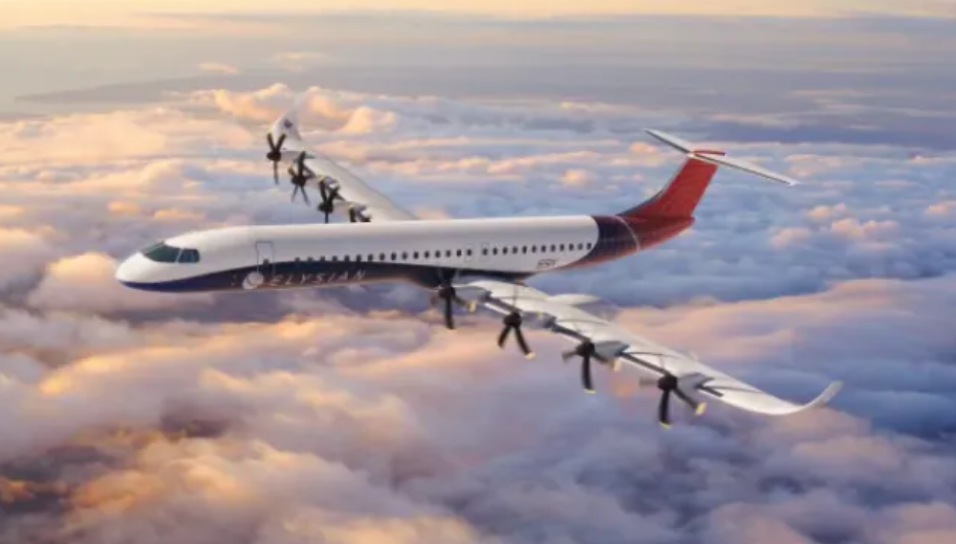Currently, commercial aviation is not on schedule to achieve net-zero emissions by 2050 and is having difficulty reducing its influence on the environment. There don’t seem to be many alternatives to fuel-hungry jet engines and turboprops in the near future, and the production of sustainable aviation fuel is not keeping up with demand.
One issue is that electrifying airplanes is more difficult than it is for automobiles, and industry experts generally agree that advancements in battery technology are necessary before electric passenger aircraft are practical.
With its intentions to build a fully electric regional aircraft that can reduce emissions by 90% and has a range of 500 miles (805 kilometers) and room for 90 passengers, the Dutch startup Elysian is challenging this notion. The aircraft is expected to be operational for commercial use within ten years.
Reynard de Vries, head of design and engineering at Elysian, states that “many experts say you need battery technology beyond [anything that will be available until] 2050 to get reasonable range and payload capability.” “How do I get the maximum range for the battery technology that we already have?” was the question we asked ourselves, though. If you make the correct decisions, battery-powered electric aircraft can go significantly farther than most studies suggest.
The E9X plane is now simply a concept; Elysian intends to construct a scale model in two to three years and a full-size prototype by 2030. But its primary design elements are already well known and come as a bit of a surprise. A frequent misperception is that electric planes should essentially be electrified copies of the lightest regional turboprops, but de Vries corrects us by saying that you shouldn’t expect that an electric plane will look like the (most successful) planes of today.
He claims it would put the range too short, maybe less than sixty miles. Essentially, you must create the design from the ground up, beginning with a blank page. The result is a plane that, for example, has weight proportions far more akin to vintage 1960s jets. a plane having a significant battery percentage and a relatively low structural weight percentage. As a result, the aircraft is significantly heavier and larger than initially believed, but it can fly far farther.
With eight propeller engines and a wingspan of nearly 138 feet (42 meters), the E9X will be larger than an Airbus A320 or a Boeing737, despite the fact that both aircraft can accommodate more than twice as many people. Additionally, de Vries claims that the E9X’s thinner fuselage will enhance its structural and aerodynamic qualities.
The oldest and biggest technical university in the Netherlands, Delft University of Technology, collaborated with de Vries to create this design. Rob Wolleswinkel, co-founder of Elysian, and de Vries wrote a scientific paper titled “A new perspective on battery-electric aviation” that explains the design’s principles.
The batteries will be installed in the wings rather than the fuselage, which is one of the main principles. According to de Vries, “it’s an important design decision.” “You want to put weight where the lift is being generated, and batteries make up a significant portion of the plane’s weight.”
According to de Vries, there won’t be a significant development in battery technology; rather, it will be comparable to what’s already on the market plus whatever breakthroughs make over the next four to five years. He continues, “That opens up different scenarios.” The most conservative estimate places the useful range at 300 miles (482 kilometers), but we think 500 miles is a more reasonable goal to aim for in four years.
Other known design features include the landing gear being located in the wings rather than the fuselage, foldable wingtips for storage, and a gas-turbine-powered “reserve energy system” that can supply backup power in the event of an emergency.
Taking into consideration the energy required for the construction of the batteries and their recharging, de Vries anticipates that the aircraft will have an overall climate impact that is between 75 and 90 percent less than that of current narrowbody jets.
The E9X won’t require any upgrades or modifications because it is made to work with the existing airport infrastructure. However, because charging the batteries takes longer than filling up the tank with petrol, there may be a problem with turnaround time. Our current goal is a maximum charging time of 45 minutes, which would need a little longer turnaround time than certain airlines—particularly the low-cost carriers—are accustomed to. However, that’s the maximum amount of time; the typical duration will be about 30 minutes.
He continues, “There are ongoing discussions with airlines around the world,” and “regional and commuter airlines will probably be interested in the plane.” De Vries added that it might help secondary airfields that are underutilized at the moment due to restrictions on noise or pollution or because it is not financially viable for airlines to use them.
Last but not least, he thinks the E9X will provide passengers with a quieter, more pleasurable flight experience and will address one of the major problems with modern travel: the lack of cabin luggage space.–CNN


Comments are closed, but trackbacks and pingbacks are open.